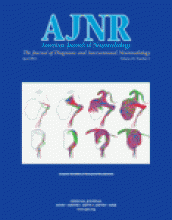
J. Randy Jinkins. Baltimore, MD: Lippincott Williams & Wilkins; 2000. 732 pages, 1232 illustrations. $185.
In their 732-page atlas, J. Randy Jinkins and approximately a dozen contributors have assembled an impressive variety of schematic drawings, MR images, CT scans, angiograms, and radiographs in an attempt to define a body of neuroanatomic information that will be both useful and “complete” for the practice of neuroradiology. The anatomic structures are labeled with numbers on most of the figures and are listed in numerical order in the corresponding figure legends. Twenty or more structures are identified in many, if not most, of the drawings (eg, midline sagittal brain anatomy), whereas 10 or fewer structures, usually the obvious ones, are identified routinely on the MR images and CT scans. Although the reader cannot expect detailed labeling of all diagnostic images, additional labeling would have made the Atlas of Neuroradiologic Embryology, Anatomy, and Variants more useful as a resource during image interpretation sessions. In particular, the anatomy of the gyri of the cerebral hemispheres, as displayed on cross-sectional and 3D surface-rendered MR images, could be labeled more extensively, especially in this era of functional MR imaging. Although not as detailed as high resolution digital images of gross anatomic brain specimens, the 3D surface-rendered MR images do provide perspective and textural variation that augment the traditional line drawings, which dominate the book.
The book is organized into eight chapters: Embryology, Cranium (>50% of the book’s length), Sella/Pituitary/Cavernous Sinus, Orbit, Facial Structures, Paranasal Sinuses, Spine, and Neck. As one would expect, the Cranium and the Spine chapters are divided into multiple parts that cover parenchymal/meningeal, skeletal, and vascular anatomy and the anatomy of the cranial and spinal nerves, major neural plexuses (referred to as plexi by the authors, yet my copy of Stedman’s Medical Dictionary does not show plexi as the pleural of plexus), and the sympathetic and parasympathetic systems. Several parts of the book provided insights into the anatomy that I found valuable in my practice: 1) the part on sutures, synchondroses, and fontanelles, 2) an axial section schematic drawing of the internal capsule at the level of the midthalamus and lentiform nucleus, 3) a drawing of venous vascular territories of the cerebrum, 4) a parasagittal cross-section schematic drawing of the contents of the spinal neural foramina, and 5) the paraspinal muscles in the neck and the back. The chapter on Embryology avoids the tedium that often besets this difficult subject by focusing on structures often scrutinized by neuroradiologists, such as the pituitary gland and auditory apparatus, and by including schematic drawings of postnatal developmental changes for the paranasal sinuses and the spinal cord and spinal column.
The authors have brought together a large and diverse collection of anatomic drawings and images relevant to the practice of neuroradiology. A few “significant” omissions were apparent, such as the lack of a drawing of the level system for reporting abnormal cervical lymph nodes. The abundance of drawings (apparently requiring three illustrators) and tables, which provide information “pearls” and key teaching points from the authors’ experiences, are the strengths of this atlas. The primary weakness is a lack of cohesiveness, probably resulting from the authors’ attempts to provide a wide breadth of coverage of neuroanatomy. Thus, the reader must work harder to extract the full benefit from the information presented. This becomes apparent when searching for schematic drawings or images that show different perspectives of the same structure, such as the subthalamus, because there is little or no cross-referencing of the different depictions in the Subject Index or in the descriptive text that accompanies the figures.
In summary, Jinkins and colleagues have made great progress toward their goal of “more clearly and concisely defining the contents and presently known limits of… neuroanatomy, and… how neuroanatomy applies to neurodiagnostic imaging.” The scope of the neuroanatomic information presented remains broad yet it is appropriately focused and is reinforced by the authors’ insights expressed in the tables and main text. Although somewhat lacking in cohesiveness, the book is often better suited to the needs of the practicing radiologist than are the multiple reference sources that have been required in the past. The value of this Atlas will become evident to the (neuro)radiologist as soon as he or she is confronted by a lesion that involves less-than-familiar anatomy, such as the paraspinal musculature, the infratentorial veins, or one of the developmental vertebral clefts.
- Copyright © American Society of Neuroradiology












